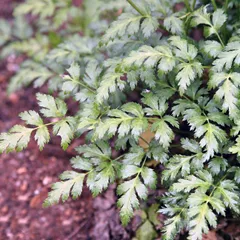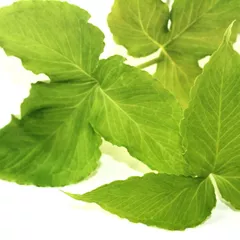Use of Gan Jiang (dried ginger) in TCM
Please note that you should never self-prescribe TCM ingredients. A TCM ingredient is almost never eaten on its own but as part of a formula containing several ingredients that act together. Please consult a professional TCM practitioner, they will be best able to guide you.
Preparation: Remove impurities, wash and soak in water to moisten, cut in thick pieces and dry
Dosage: 3 - 9 grams
Main actions according to TCM*: Warms the Spleen and expels Cold. Restores collapse of Yang and expels Interior Cold. Warms the Lungs and assists expectoration of Cold Phlegm. Stops chronic bleeding caused by Cold.
Primary conditions or symptoms for which Gan Jiang may be prescribed by TCM doctors*: Abdominal pain Phlegm Vomiting Dyspnea Coughing Diarrhea Asthma Abnormal uterine bleeding
Contraindications*: This herb should not be used by those with Yin Deficiency and Heat signs or bleeding associated with Hot Blood. This herb should be used with extreme caution during pregnancy. May enhance risk of bleeding when ginger is used together with the blood thinning drug Warfarin
Common TCM formulas in which Gan Jiang is used*
Ling Gan Wu Wei Jiang Xin Tang
Source date: 220 AD
Number of ingredients: 5 herbs
Formula key actions: Warms the Lungs. Transforms congested Fluids.
Conditions targeted*: Chronic bronchitisChronic asthma and others
Gan Jiang is a king ingredient in Ling Gan Wu Wei Jiang Xin Tang. Like the name indicates, it means it has more power than other ingredients in the formula.
In Ling Gan Wu Wei Jiang Xin Tang, Gan Jiang warms the Lungs, disperses Cold, and transforms thin mucus. It also warms the Spleen Yang to eliminate Dampness.
Li Zhong Wan
Source date: 220 AD
Number of ingredients: 4 herbs
Formula key actions: Warms the Middle Burner. Strengthens the Spleen and Stomach.
Conditions targeted*: GastroenteritisPeptic ulcers and others
Gan Jiang is a king ingredient in Li Zhong Wan. Like the name indicates, it means it has more power than other ingredients in the formula.
In Li Zhong Wan, Gan Jiang warms the Spleen and Stomach Yang and eliminates Interior Cold, the primary function of this formula.
Gan Cao Gan Jiang Tang
Source date: 220 AD
Number of ingredients: 2 herbs
Formula key actions: Warms the Lungs. Strengthens the Stomach.
Conditions targeted*: EnuresisExcessive drooling and others
Gan Jiang is a king ingredient in Gan Cao Gan Jiang Tang. Like the name indicates, it means it has more power than other ingredients in the formula.
In Gan Cao Gan Jiang Tang, Gan Jiang warms the Lungs and disperses Cold. Its primary function is to restore the Yang in chest. However, its acrid and hot nature can hurt the Lungs by depleting the source Qi. To overcome this problem, blast fried Ginger is recommended as its acrid and dispersing effect is reduced.
Hui Yang Jiu Ji Tang
Source date: 1445 AD
Number of ingredients: 11 herbs
Formula key actions: Restores and revives the Yang. Augments the Qi. Revives the pulse.
Conditions targeted*: Myocardial infarctionCardiogenic shock and others
Gan Jiang is a king ingredient in Hui Yang Jiu Ji Tang. Like the name indicates, it means it has more power than other ingredients in the formula.
In Hui Yang Jiu Ji Tang, Gan Jiang is hot and strong. It is able to restore and revive the Yang, stem rebelliousness, augment the Qi and generate the pulse.
It is used in the situation that the Yang is exhausted and Cold invades all three Yin warps.
Ban Xia Xie Xin Tang
Source date: 220 AD
Number of ingredients: 7 herbs
Formula key actions: Reverses the flow of Rebellious Stomach Qi. Relieves both Heat and Cold Stagnation in the gastrointestinal tract.
Conditions targeted*: Peptic ulcersGastroesophageal reflux disease and others
Gan Jiang is a deputy ingredient in Ban Xia Xie Xin Tang. This means it helps the king ingredient(s) treat the main pattern or it serves to treat a coexisting pattern.
In Ban Xia Xie Xin Tang, Gan Jiang enters the Spleen and Stomach to assist in the transformation of thin mucus while restoring Yang Qi to the Middle Burner.
Xiao Qing Long Tang
Source date: 220 AD
Number of ingredients: 8 herbs
Formula key actions: Releases the Exterior. Transforms Phlegm-Fluids. Warms the Lungs. Directs Rebellious Qi downward.
Conditions targeted*: Upper respiratory tract infectionsBronchitis and others
Gan Jiang is a deputy ingredient in Xiao Qing Long Tang. This means it helps the king ingredient(s) treat the main pattern or it serves to treat a coexisting pattern.
In Xiao Qing Long Tang, Gan Jiang works together with Wild ginger (Xi Xin), the other deputy herb in this formula, to warm the Interior, transform Phlegm-Fluids, and help the key herbs (Ephedra and Cinnamon twigs) release the Exterior.
It is particularly effective at warming the Spleen, the deficiency of which is the primary cause of the Phlegm-Fluids.
Wild ginger also stops the coughing by facilitating the flow of Qi throughout the body.
Si Ni Tang
Source date: 220 AD
Number of ingredients: 3 herbs
Formula key actions: Rescues devastated Yang. Warms the Middle Burner. Stops diarrhea.
Conditions targeted*: Acute cardiac insufficiencyCerebrovascular insufficiency and others
Gan Jiang is a deputy ingredient in Si Ni Tang. This means it helps the king ingredient(s) treat the main pattern or it serves to treat a coexisting pattern.
In Si Ni Tang, Gan Jiang warms the Middle Burner and eliminates Cold, which strengthens the Spleen's functions of transforming and transporting food and fluids.
Da Jian Zhong Tang
Source date: 220 AD
Number of ingredients: 4 herbs
Formula key actions: Warms and tonifies Middle Burner Deficiency. Directs rebellious Qi downward. Relieves pain.
Conditions targeted*: Chronic gastritisGastric ulcer and others
Gan Jiang is a deputy ingredient in Da Jian Zhong Tang. This means it helps the king ingredient(s) treat the main pattern or it serves to treat a coexisting pattern.
In Da Jian Zhong Tang, Gan Jiang supports the key herbs in warming the Middle Burner. It also prevents the Cold Stomach Qi going upwards so as to ease vomiting.
Wen Pi Tang
Source date: 650 AD
Number of ingredients: 5 herbs
Formula key actions: Warms and tonifies the Spleen Yang. Clears Cold Evil.
Conditions targeted*: Ulcerative colitisChronic bacillary dysentery and others
Gan Jiang is a deputy ingredient in Wen Pi Tang. This means it helps the king ingredient(s) treat the main pattern or it serves to treat a coexisting pattern.
In Wen Pi Tang, Gan Jiang serves as the deputy by concentrating the formula's activity on the Spleen Yang.
It is acrid and warming and it penetrates the Spleen and Stomach Channels.
Together with Prepared aconite, they supports the Spleen
Yang so as to eliminate the Cold Evil.
San Wu Bei Ji Wan
Source date: 220 AD
Number of ingredients: 3 herbs
Formula key actions: Clear Cold Stagnation.
Conditions targeted*: Postoperative adhesionsIntestinal obstruction and others
Gan Jiang is a deputy ingredient in San Wu Bei Ji Wan. This means it helps the king ingredient(s) treat the main pattern or it serves to treat a coexisting pattern.
In San Wu Bei Ji Wan, Gan Jiang assists the Croton fruit in dispelling Coldness. It also revives the Spleen Yang.
Huang Lian Tang
Source date: 220 AD
Number of ingredients: 7 herbs
Formula key actions: Regulates Cold and Heat. Harmonizes the Stomach. Directs Rebellious Qi downward.
Conditions targeted*: GastritisHyperacidic stomach and others
Gan Jiang is a deputy ingredient in Huang Lian Tang. This means it helps the king ingredient(s) treat the main pattern or it serves to treat a coexisting pattern.
In Huang Lian Tang, Gan Jiang is acrid, warm and dispersing herb which expel Cold from the lower body to stop pain. It also excels at warming the Spleen.
Tao Hua Tang
Source date: 220 AD
Number of ingredients: 3 herbs
Formula key actions: Warms the Middle. Dispels Cold. Binds up the bowels and stops dysenteric disorders.
Conditions targeted*: Ulcerative colitisCrohn's disease and others
Gan Jiang is a deputy ingredient in Tao Hua Tang. This means it helps the king ingredient(s) treat the main pattern or it serves to treat a coexisting pattern.
In Tao Hua Tang, Gan Jiang calms the Middle Burner and expels Cold.
It also assists the original Yang and strengthens the
Spleen's transportive and transformative functions so that it is able to contain Essence.
Experts also emphasizes that its warmth nature can dispels Cold from the Blood and its acridity nature can clear Stagnation. Therefore this herb is effective in solving the root and branch causes of pus, such as these blood and pus in the stools.
Ge Hua Jie Cheng San
Source date: 13th century
Number of ingredients: 13 herbs
Formula key actions: Separates and reduces alcohol-dampness. Warms the Middle. Strengthens the Spleen .
Conditions targeted*: HangoversAlcoholism and others
Gan Jiang is a deputy ingredient in Ge Hua Jie Cheng San. This means it helps the king ingredient(s) treat the main pattern or it serves to treat a coexisting pattern.
In Ge Hua Jie Cheng San, Gan Jiang warm the Middle Burner, strengthen the Spleen, harmonize the Stomach and invigorate Qi. Thus, the Spleen gains control over the accumulation of Dampness.
Feng Yin Tang
Source date: 220 AD
Number of ingredients: 12 herbs
Formula key actions: Extinguishes and pacifies Wind with heavy medicinals. Calms the Mind. Clears Heat.
Conditions targeted*: EpilepsyStroke and others
Gan Jiang is a deputy ingredient in Feng Yin Tang. This means it helps the king ingredient(s) treat the main pattern or it serves to treat a coexisting pattern.
In Feng Yin Tang, Gan Jiang is acrid, warming, and sweet. It protects the Middle Burner from the excessive coldness of the cooling ingredients.
Gui Zhi Ren Shen Tang
Source date: 220 AD
Number of ingredients: 5 herbs
Formula key actions: Releases the Exterior. Warms the Interior. Augments the Qi. Eliminates focal distention .
Conditions targeted*: Peptic ulcersChronic cholecystitis and others
Gan Jiang is a deputy ingredient in Gui Zhi Ren Shen Tang. This means it helps the king ingredient(s) treat the main pattern or it serves to treat a coexisting pattern.
In Gui Zhi Ren Shen Tang, Gan Jiang is acrid and heating. It warms the Middle Burner, dispelling Interior Cold and boosting the Spleen and Stomach Yang Qi.
If the Spleen's transportive and transformative functions fail, Dampness accumulates.
Wu Ji San
Source date: 846 AD
Number of ingredients: 15 herbs
Formula key actions: Releases the Exterior. Warms the Interior. Smoothes the flow of Qi. Transforms Phlegm. Invigorates the Blood. Reduces Stagnation.
Conditions targeted*: BronchiolitisSciatica and others
Gan Jiang is a deputy ingredient in Wu Ji San. This means it helps the king ingredient(s) treat the main pattern or it serves to treat a coexisting pattern.
In Wu Ji San, Gan Jiang warms the Interior and expel Cold.
The four key herbs in the formula work together to addresses Cold Evil in both the Exterior and Interior.
Wu Mei Wan
Source date: 220 AD
Number of ingredients: 9 herbs
Formula key actions: Warms the Organs. Drains Heat. Calms roundworms. Drains the Liver. Calms the Stomach.
Conditions targeted*: AscariasisBiliary ascariasis and others
Gan Jiang is an assistant ingredient in Wu Mei Wan. This means that it either serves to reinforces the effect of other ingredients or it moderates their toxicity.
In Wu Mei Wan, Gan Jiang warms the Interior and is very useful in dispersing internal Cold.
Chai Hu Gui Jiang Tang
Source date: 220 AD
Number of ingredients: 7 herbs
Formula key actions: Harmonizes and releases the Lesser Yang. Removes Stagnation . Warms the Interior. Dispels Cold.
Conditions targeted*: Common coldMalaria and others
Gan Jiang is an assistant ingredient in Chai Hu Gui Jiang Tang. This means that it either serves to reinforces the effect of other ingredients or it moderates their toxicity.
In Chai Hu Gui Jiang Tang, Gan Jiang promotes Qi circulation in the Middle Burner.
It also warms the Yang Qi of the Spleen, and enables it to transform accumulated Body Fluids.
Shi Wei Bai Du San
Source date: 1760-1835 AD
Number of ingredients: 10 herbs
Formula key actions: Dispels Wind and transforms Dampness. Clears Toxic Heat .
Conditions targeted*: AcneBoils and others
Gan Jiang is an assistant ingredient in Shi Wei Bai Du San. This means that it either serves to reinforces the effect of other ingredients or it moderates their toxicity.
In Shi Wei Bai Du San, Gan Jiang harmonizes the Stomach.
Shao Fu Zhu Yu Tang
Source date: 1830 AD
Number of ingredients: 10 herbs
Formula key actions: Expels Cold and warm the menstruation Blood. Stops pain. Invigorates Blood. Dispels Blood stagnation.
Conditions targeted*: Chronic pelvic inflammatory diseasePrimary dysmenorrhea and others
In Shao Fu Zhu Yu Tang, Gan Jiang warms the Uterus and expels Cold
Gu Ben Zhi Beng Tang
In Gu Ben Zhi Beng Tang, Gan Jiang warms the Channels and stops bleeding.
Key TCM concepts behind Gan Jiang's properties
In Traditional Chinese Medicine (TCM), Gan Jiang belongs to the 'Herbs that warm the Interior and/or expel Cold' category. Herbs in this category are used for Internal Cold with Qi Deficiency and/or Yang Deficiency. In the Yin and Yang system of thought Yang is Hot in nature. A deficiency of Yang will therefore lead to Internal Coldness since there will as a result be more Yin (Cold in nature) than Yang. In extreme cases this can lead to so-called 'Yang collapse' with convulsions or coma and these herbs are particularly indicated to treat such scenarios.
As suggested by its category Gan Jiang is Hot in nature. This means that Gan Jiang typically helps people who have too much "Cold" in their body. Balance between Yin and Yang is a key health concept in TCM. Those who have too much 'Cold' in their body are said to either have a Yin Excess (because Yin is Cold in nature) or a Yang Deficiency (Yang is Hot in Nature). Depending on your condition Gan Jiang can help restore a harmonious balance between Yin and Yang.
Gan Jiang also tastes Pungent. The so-called 'Five Phases' theory in Chinese Medicine states that the taste of TCM ingredients is a key determinant of their action in the body. Pungent ingredients like Gan Jiang tends to promote the circulations of Qi and Body Fluids. That's why for instance someone tends to sweat a lot when they eat spicy/pungent food.
The tastes of ingredients in TCM also determine what Organs and Meridians they target. As such Gan Jiang is thought to target the Heart, the Kidney, the Lung and the Stomach. In addition to regulating Blood flow, in TCM the Heart is believed to be the store of the 'Mind' which basically refers to someone's vitality. The Kidneys do not only regulate the urinary system but also play a key role in the reproductive system and the growth and aging process of the body. In addition to performing respiration, the Lungs are thought in TCM to be a key part of the production chain for Qi and the Body Fluids that nourish the body. The Stomach is responsible for receiving and ripening ingested food and fluids. It is also tasked with descending the digested elements downwards to the Small Intestine.
Research on Gan Jiang
3 months supplementation of ginger improved glycemic indices and total antioxidant capacity in patients with type 2 diabetes.1
Treatment of primary dysmenorrhea in students with ginger for 5 days had a statistically significant effect on relieving intensity and duration of pain.2
Ginger powder has add-on effect on reducing the symptoms of osteoarthritis of knee with acceptable safety profile.3
Ginger supplementation at a daily dose of 0.5 g-1.0 g significantly aids in reduction of the severity of acute chemotherapy-induced nausea in adult cancer patients.4
Ginger can be considered as a useful treatment option for women suffering from morning sickness.5
Sources:
1. Shidfar F, Rajab A, Rahideh T, Khandouzi N, Hosseini S, Shidfar S. ( 2015). The effect of ginger (Zingiber officinale) on glycemic markers in patients with type 2 diabetes. J Complement Integr Med. , 12(2):165-70. doi: 10.1515/jcim-2014-0021.
2. Rahnama P, Montazeri A, Huseini HF, Kianbakht S, Naseri M. ( 2012 ). Effect of Zingiber officinale R. rhizomes (ginger) on pain relief in primary dysmenorrhea: a placebo randomized trial. BMC Complement Altern Med. , 12:92. doi: 10.1186/1472-6882-12-92.
3. Paramdeep G. (2013). Efficacy and tolerability of ginger (Zingiber officinale) in patients of osteoarthritis of knee. Indian J Physiol Pharmacol. , 57(2):177-83.
4. Ryan JL, Heckler CE, Roscoe JA, Dakhil SR, Kirshner J, Flynn PJ, Hickok JT, Morrow GR. (2012). Ginger (Zingiber officinale) reduces acute chemotherapy-induced nausea: a URCC CCOP study of 576 patients. Support Care Cancer. , 20(7):1479-89. doi: 10.1007/s00520-011-1236-3. Epub 2011 Aug 5.
5. Willetts KE, Ekangaki A, Eden JA. (2003). Effect of a ginger extract on pregnancy-induced nausea: a randomised controlled trial. Aust N Z J Obstet Gynaecol. 43(2):139-44.
Use of Gan Jiang as food
Gan Jiang is also eaten as food. It is used as an ingredient in dishes such as Candied ginger or Gingerbread.































